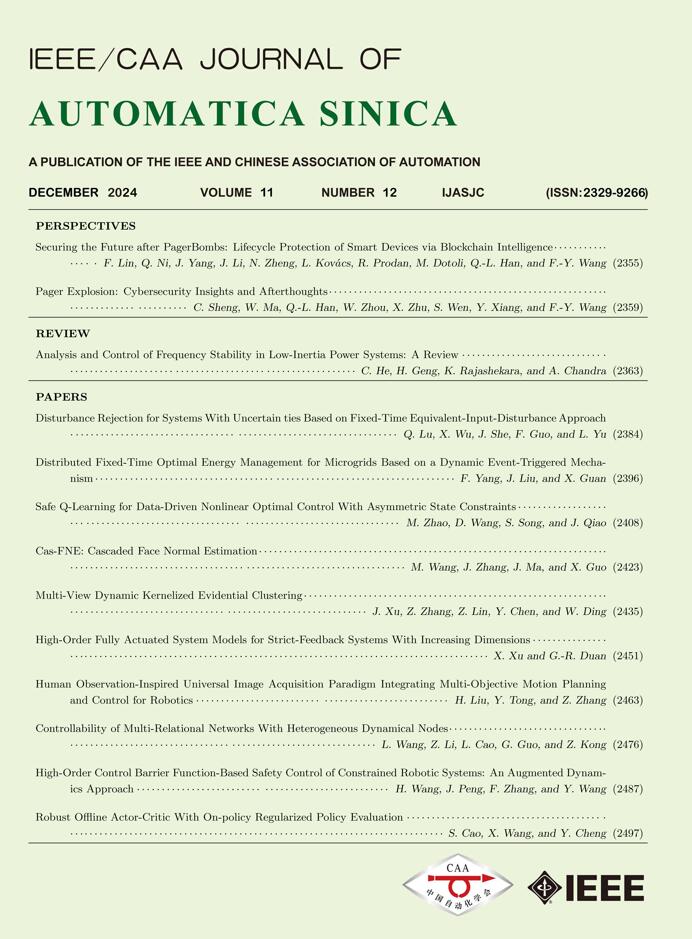 Volume 11
Issue 12
Volume 11
Issue 12
IEEE/CAA Journal of Automatica Sinica
| Citation: | A. Qiu, Y. Hu, and J. Wu, “Event-triggered fault detection — An integrated design approach directly toward fault diagnosis performance,” IEEE/CAA J. Autom. Sinica, vol. 11, no. 12, pp. 2528–2530, Dec. 2024. doi: 10.1109/JAS.2023.124074 |

| [1] |
X. Zhang, Q. Han, and B. Zhang, “An overview and deep inves- tigation on sampled-data-based event-triggered control and filtering for networked systems,” IEEE Trans. Industrial Informatics, vol. 13, no. 1, pp. 4–16, 2017. doi: 10.1109/TII.2016.2607150
|
| [2] |
L. Ding, Q.-L. Han, X. Ge, and X. Zhang, “An overview of recent advances in event-triggered consensus of multiagent systems,” IEEE Trans. Cyber., vol. 48, no. 4, pp. 1110–1123, 2018. doi: 10.1109/TCYB.2017.2771560
|
| [3] |
G. Zhang, J. Li, X. Jin, and C. Liu, “Robust adaptive neural control for wing-sail-assisted vehicle via the multiport event-triggered approach,” IEEE Trans. Cyber., vol. 52, no. 12, pp. 12916–12928, 2022. doi: 10.1109/TCYB.2021.3091580
|
| [4] |
M. Zhong, X. Zhu, T. Xue, and L. Zhang, “An overview of recent advances in model-based event-triggered fault detection and estimation,” Int. J. Syst. Science, vol. 54, no. 4, pp. 929–943, 2023. doi: 10.1080/00207721.2022.2146990
|
| [5] |
H. Alikhani and N. Meskin, “Event-triggered robust fault diagnosis and control of linear Roesser systems: A unified framework,” Automatica, vol. 128, p. 109575, 2021. doi: 10.1016/j.automatica.2021.109575
|
| [6] |
A. Qiu, A. Al-Dabbagh, and T. Chen, “A tradeoff approach for optimal event-triggered fault detection,” IEEE Trans. Industrial Electronics, vol. 66, no. 3, pp. 2111–2121, 2019. doi: 10.1109/TIE.2018.2840510
|
| [7] |
M. Zhong, S. Ding, D. Zhou, and X. He, “An $H_i/{H_\infty }$ optimization approach to event-triggered fault detection for linear discrete time systems,” IEEE Trans. Autom. Control, vol. 65, no. 10, pp. 4464–4471, 2020. doi: 10.1109/TAC.2020.3006811
|
| [8] |
M. Gao, L. Sheng, D. Zhou, and Y. Niu, “Event-based fault detection for T-S fuzzy systems with packet dropouts and $(x, v)$-dependent noises,” Signal Processing, vol. 138, pp. 211–219, 2017. doi: 10.1016/j.sigpro.2017.03.026
|
| [9] |
P. Zhang and S. X. Ding, “An integrated trade-off design of observer based fault detection systems,” Automatica, vol. 44, no. 7, pp. 1886–1894, 2008. doi: 10.1016/j.automatica.2007.11.021
|
| [10] |
W. Chen, A. khan, M. Abid, and S. Ding, “Intergrated designed of observed based fault detection for a class of uncertain nonlinear systems,” Int. J. Applied Math. and Computer Science, vol. 21, no. 3, pp. 423–430, 2011. doi: 10.2478/v10006-011-0031-0
|
| [11] |
Y. Wan, W. Dong, H. Wu, and H. Ye, “Integrated fault detection system design for linear discrete time-varying systems with bounded power disturbances,” Int. J. Robust and Nonlinear Control, vol. 23, no. 16, pp. 1781–1802, 2013. doi: 10.1002/rnc.2847
|
| [12] |
W. W. Sun, Y. Wu, and X. Lv, “Adaptive neural network control for full-state constrained robotic manipulator with actuator saturation and time-varying delays,” IEEE Trans. Neural Network and Learning Systems, vol. 33, no. 8, pp. 3331–3342, 2022. doi: 10.1109/TNNLS.2021.3051946
|
| [13] |
S. Ding, Model-Based Fault Diagnosis Techniques: Design Schemes, Algorithms, and Tools, Berlin, Germany: Springer, 2013.
|